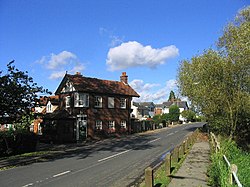Stondon Massey
| Stondon Massey | |
| Essex | |
|---|---|
 The Bricklayers Arms, Stondon Massey | |
| Location | |
| Grid reference: | TL584004 |
| Location: | 51°40’48"N, -0°17’31"E |
| Data | |
| Population: | 767 (2011[1]) |
| Post town: | Brentwood |
| Postcode: | CM15 |
| Dialling code: | 01277 |
| Local Government | |
| Council: | Brentwood |
| Parliamentary constituency: |
Brentwood and Ongar |
Stondon Massey is a village and parish in the Ongar hundred of Essex. The village is to the north of Brentwood, between Blackmore and Doddinghurst.
Stondon Massey hosts an annual fete on the village green[2]. In 2006 the village was named Winner of Group 4 Best Kept Village in Essex competition[3].
Etymology and history
Stondon means "stone hill",[4] a Saxon settlement was established near to the site of the 12th-century church of St Peter’s & St Paul’s, where William Byrd, the Tudor composer is likely to be buried.[5] A low gravel hill was known as a ‘down’. Hence the name Stondon. Massey is derived from the surname of Serlo de Marcy, a Norman knight who lived in Marks Hall, Margaret Roding[6].
There have been three successive manor houses, the oldest of which is Stondon Hall, near the church. The north wing of the Hall is probably of the 15th century, and there is some 16th- and 17th-century panelling inside. Stondon Place, originally a farmhouse, was rebuilt about 1707, and again after a fire, about 1880. From 1593 to 1623, it was the home of William Byrd, the musician.[7]
The church of St Peter and St Paul retains the nave and chancel and some of the original round-headed arches of 1100. There is a brass of 1570 to John Carre, Ironmonger and Merchant Adventurer of London, with figures of himself and his two wives, and another, of 1573, to Rainold Hollingsworth. Nathaniel Ward, Rector of Stondon from 1623 to 1633, was deprived of his living for non-conformity. He subsequently emigrated to New England and helped draft the 1641 Code of Laws for Massachusetts.[8]
The main part of the village is now just over a mile to the south of the church probably due to the plague of 1350.[9] Stondon Massey is still mainly rural, but there has been some suburban building during the past 30 years.
References
- ↑ "Civil Parish population 2011". Neighbourhood Statistics. Office for National Statistics. http://www.neighbourhood.statistics.gov.uk/dissemination/LeadKeyFigures.do?a=7&b=11129158&c=Stondon+Massey&d=16&e=62&g=6423360&i=1001x1003x1032x1004&m=0&r=1&s=1473241192078&enc=1. Retrieved 7 September 2016.
- ↑ "Bricklayers Arms". https://www.facebook.com/pg/bricklayers.stondon/about/. Retrieved 11 February 2018.
- ↑ "Brentwood council magazine". http://www.brentwood.gov.uk/pdf/pdf_1123.pdf. Retrieved 11 February 2018.
- ↑ "Stondon Massey: Introduction". http://www.british-history.ac.uk/vch/essex/vol4/pp240-242.
- ↑ Grove's Dictionary of Music and Musicians (5 ed.). Macmillan. 1954. pp. 1056–1057.
- ↑ "Stondon Massey: Manor". http://www.british-history.ac.uk/vch/essex/vol4/pp242-245.
- ↑ "William Byrd - Britannica". https://www.britannica.com/biography/William-Byrd. Retrieved 9 February 2018.
- ↑ "Massachusetts Body of Liberties". http://www.mass.gov/anf/research-and-tech/legal-and-legislative-resources/body-of-liberties.html. Retrieved 11 February 2018.
- ↑ Stondon Massey Parish Magazine
Outside links
| ("Wikimedia Commons" has material about Stondon Massey) |

This Essex article is a stub: help to improve Wikishire by building it up.
